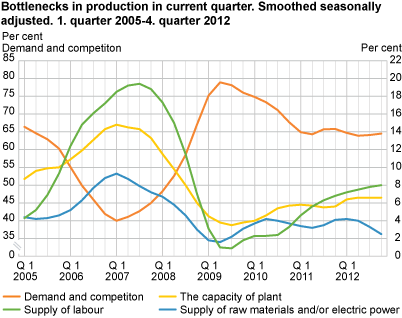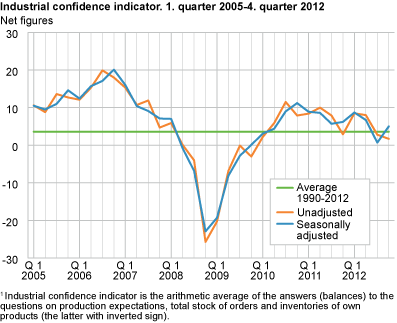Content
Published:
This is an archived release.
Gap grows between various industries
Norwegian industrial managers report that the growth in total output shows signs of levelling out. Weak demand from export markets explains this result.
According to the Business tendency survey, the Norwegian manufacturing industry experienced weak growth in total output in the fourth quarter of 2012. A similar result was recorded for employment. A further decline in new orders from export markets explains why the growth was levelling out. The fall in demand posed a major challenge for producers of export goods. However, the number of working months covered by the current stock of orders was somewhat higher than at the same time in 2011. Huge total stocks of orders among suppliers to the oil and gas sector explain this fact.
Prices continued to improve in domestic markets, while the opposite was the case in export markets. Some of the decline in export prices was due to a strengthening of the Norwegian currency. Average capacity utilisation for the Norwegian manufacturing industry is estimated at 79.8 per cent in the fourth quarter of 2012. International comparisons of average capacity utilisation are available from Eurostat .
Growth in the industrial confidence indicator
The general short-term outlook (Q1 2013) is considered to be better. Prospects of further growth in production and employment support this view. The result is also in accordance with the development in the industrial confidence indicator, which grew from 1 to 5 (seasonally-adjusted net figure) in the fourth quarter of 2012. Values above zero indicate higher output in the upcoming period. International comparisons of the industrial confidence indicator are available from Eurostat (EU), the Swedish National Institute of Economic Research (Sweden) and Statistics Denmark .
Poor conditions in export markets
Sectors producing intermediate goods like wood and wood products, paper and paper products, non-metallic mineral products, basic metals etc., experienced a fall in output and employment. A decline in total stocks due to a lack of new orders explains this development, and the poor demand caused market prices to fall. The conditions were particularly weak in export markets. Average capacity utilisation is estimated at 80 in the fourth quarter of 2012. This result lies below the historic average. The situation was especially difficult for producers of wood and wood products, paper and paper products and also non-ferrous metals.
The general short-term outlook (Q1 2013) is considered to be better, and somewhat more respondents share this view. Prospects of growth in output and new orders explain the higher optimism.
Shortage of qualified labour
Sectors producing capital goods like machinery and equipment, ships, boats and oil platforms, repair and installation etc., experienced a further increase in output and employment. However, a shortage of qualified labour hampered the growth in production. The situation was especially difficult for suppliers to the oil and gas sector. Total stocks were more or less unchanged after eight quarters of sustained growth. A fall in new orders from export markets explains this decline. Average capacity utilisation is estimated at 82.5 per cent for the industries in question. The number of working months covered by the current stock of orders was higher than in the fourth quarter of 2011 and lay above the historic average.
The general short-term outlook (Q1 2013) is considered to be better, and the investments seem to be growing. Prospects of even further growth in output and employment explain these results.
Higher demand for food products and beverages
Sectors producing consumer goods like food products and beverages, printing and reproduction, basic pharmaceuticals, furniture etc., experienced somewhat stronger growth in output. Higher demand for food products and beverages in domestic markets, and improved supply of raw materials, explain this rise. However, employment fell in the second half of 2012. Fewer employees in industries like printing and production of furniture explain some of this decline. Average capacity utilisation is estimated at 76.1 per cent in the fourth quarter of 2012. This result lies below the historic average.
The general short-term outlook (Q1 2013) is considered to be better, and the investments seem to be growing. Prospects of further growth in output, demand and market prices explain these results.
| Industry | Prospects | Background | |||||||||||||||||||||||||||||||||||||||||||||||||||||||||||||||||||||||||||||
|---|---|---|---|---|---|---|---|---|---|---|---|---|---|---|---|---|---|---|---|---|---|---|---|---|---|---|---|---|---|---|---|---|---|---|---|---|---|---|---|---|---|---|---|---|---|---|---|---|---|---|---|---|---|---|---|---|---|---|---|---|---|---|---|---|---|---|---|---|---|---|---|---|---|---|---|---|---|---|---|
| Food, beverages and tobacco | ++ | Growth in output, higher employment and a better supply of raw materials. Stronger demand and improved prices in domestic markets. The general outlook for Q1 is considered to be positive. Prospects of growth in demand and prices. Upward adjustment of planned investments. | |||||||||||||||||||||||||||||||||||||||||||||||||||||||||||||||||||||||||||||
| Wood and wood products | - (+) | Decline in output, reduced capacity utilisation and less employment. Lower total stocks due to a fall in new orders. Lower market prices. The general outlook for Q1 is considered to be positive. Prospects of growth in output and new orders from domestic markets. | |||||||||||||||||||||||||||||||||||||||||||||||||||||||||||||||||||||||||||||
| Paper and paper products | - (+) | Decline in output, less employment, weak demand in domestic markets and lower market prices. The general outlook for Q1 is considered to be positive. Prospects of growth in output and capacity utilisation. | |||||||||||||||||||||||||||||||||||||||||||||||||||||||||||||||||||||||||||||
| Basic chemicals | - | Decline in output, less employment, a fall in new orders and lower market prices. The general outlook for Q1 is considered to be neutral. Prospects of lower total stocks of orders and a further reduction in employment. Downward adjustment of planned investments. | |||||||||||||||||||||||||||||||||||||||||||||||||||||||||||||||||||||||||||||
| Non-ferrous metals | - | Decline in output, reduced capacity utilisation, and less employment. Lower total stocks due to a fall in new orders. Poor market prices. The general outlook for Q1 is considered to be negative. Prospects of a further decline in employment and new orders. Downward adjustment of planned investments. | |||||||||||||||||||||||||||||||||||||||||||||||||||||||||||||||||||||||||||||
| Fabricated metal products | + | Growth in output, higher capacity utilisation, a rise in employment and impoved market prices. Minor changes in total stocks of orders. The general outlook for Q1 is considered to be positive. Prospects of further growth in output and higher prices in domestic markets. Upward adjustment of planned investments. | |||||||||||||||||||||||||||||||||||||||||||||||||||||||||||||||||||||||||||||
| Computer and electrical equipment | + (-) | Growth in output, higher capacity utilisation, and a rise in employment. Decline in new orders and lower market prices. The general outlook for Q1 is considered to be neutral. Downward adjustment of planned investments. | |||||||||||||||||||||||||||||||||||||||||||||||||||||||||||||||||||||||||||||
| Machinery and equipment | + (-) | Minor changes in output, but higher employment. A fall in new orders and lower prices in export markets. The general outlook for Q1 is considered to be positive. Prospects of growth in output, employment and new orders. | |||||||||||||||||||||||||||||||||||||||||||||||||||||||||||||||||||||||||||||
| Ships, boats and oil platforms | + | Growth in output and higher employment. Shortage of qualified labour. A fall in new orders and lower market prices. The general outlook for Q1 is considered to be positive. Prospects of further growth in output and employment. Upward adjustment of planned investments. | |||||||||||||||||||||||||||||||||||||||||||||||||||||||||||||||||||||||||||||
| Repair, installation of machinery | ++ | Growth in output, improved capacity utilisation, higher employment and a rise in total stocks of orders. Strong demand and higher prices in domestic markets. The general outlook for Q1 is considered to be neutral. Prospects of further growth in output and capacity utilisation. Upward adjustment of planned investments. | |||||||||||||||||||||||||||||||||||||||||||||||||||||||||||||||||||||||||||||
| The column for Prospects shows an overall evaluation of the present situation and expected short-term developments using the symbols + and -. The following codes and constellations are used: | ++ + ² - -- +(-) +/- -(+) | Very good Good Stable Poor Very poor Good, but with certain negative indications A situation where the + and - factors even out | |||||||||||||||||||||||||||||||||||||||||||||||||||||||||||||||||||||||||||||
Timeliness:The survey data was collected in the period between 10 December 2012 and 24 January 2013. |
Industrial confidence indicator (ICI):The indicator is the arithmetic average of the responses (balances) to the questions on production expectations, total stock of orders and inventories of own products (the latter with an inverted sign).
The indicator is a guide to the level of industrial production since:
An expected rise in the level of output signifies increased production in the forthcoming quarter. An increase in the total stock of orders indicates a higher level of production due to the future fulfilment of these orders. An increase in the inventories of own products indicates slow sales and reduced activity.
|
Tabeller
Charts
Additional information
The statistics provide current data on the business cycle for manufacturing, mining and quarrying by collecting business leaders’ assessments of the economic situation and the short term outlook.
Contact
-
Edvard Andreassen
E-mail: edvard.andreassen@ssb.no
tel.: (+47) 40 90 23 32
-
Ståle Mæland
E-mail: stale.maeland@ssb.no
tel.: (+47) 95 05 98 88


